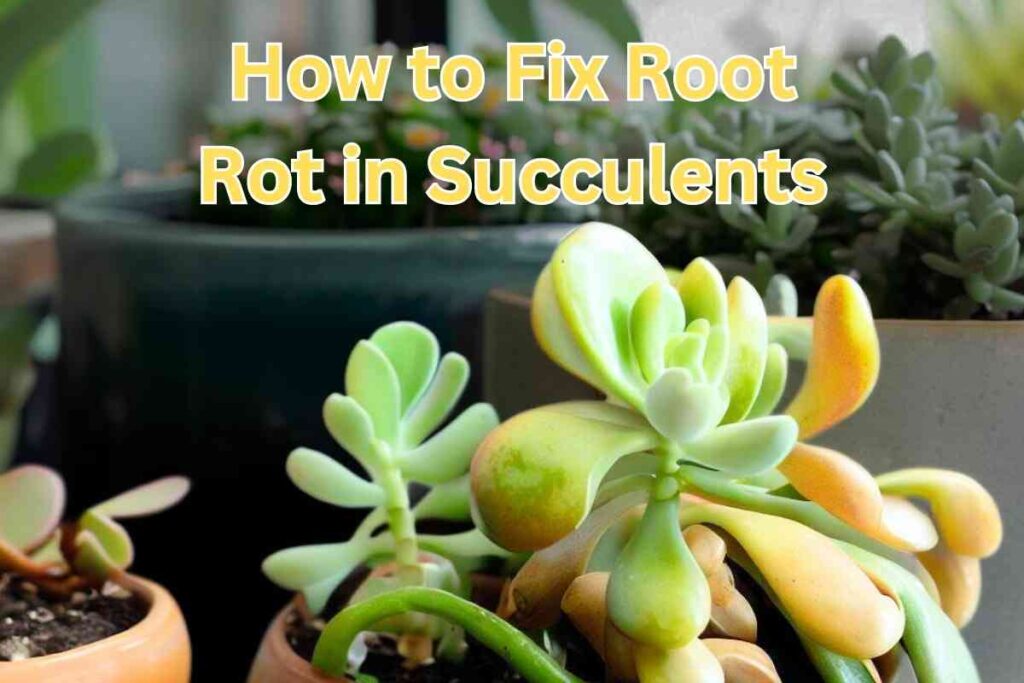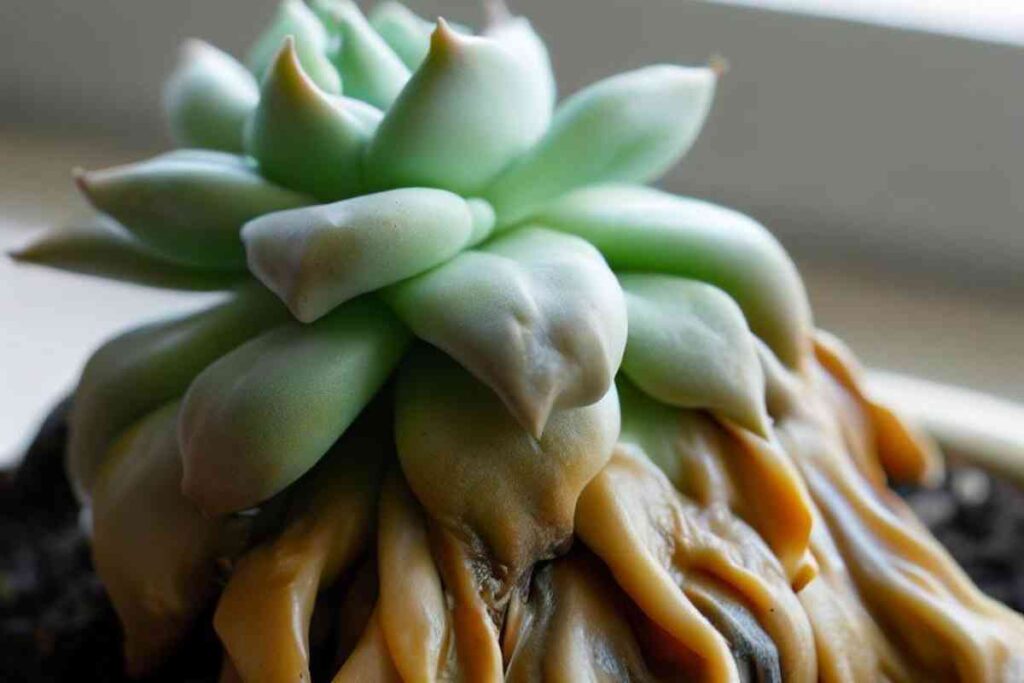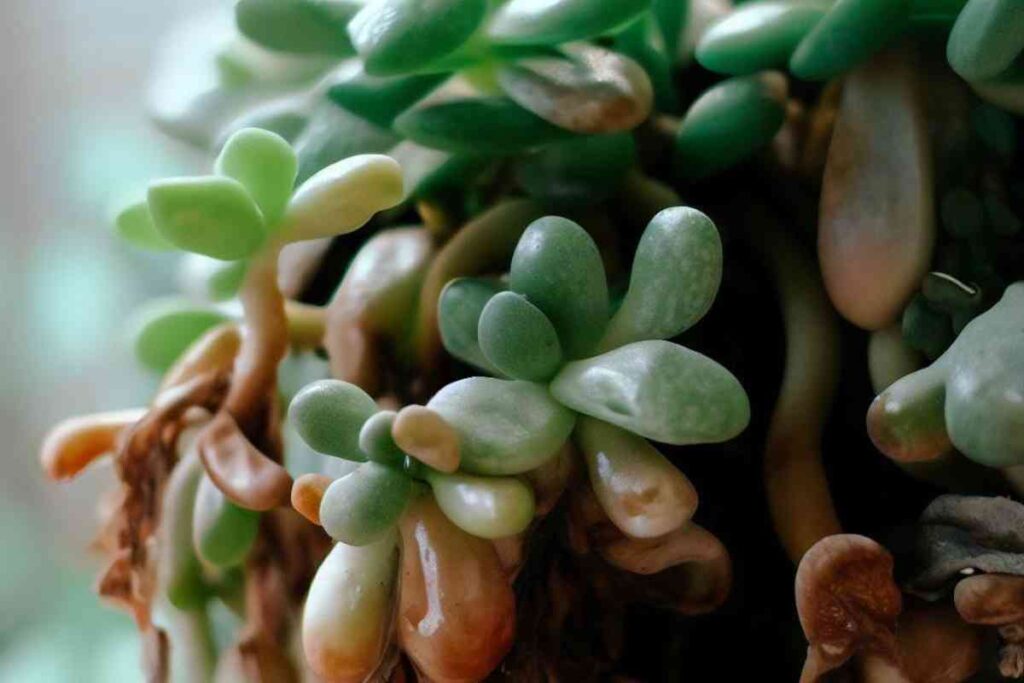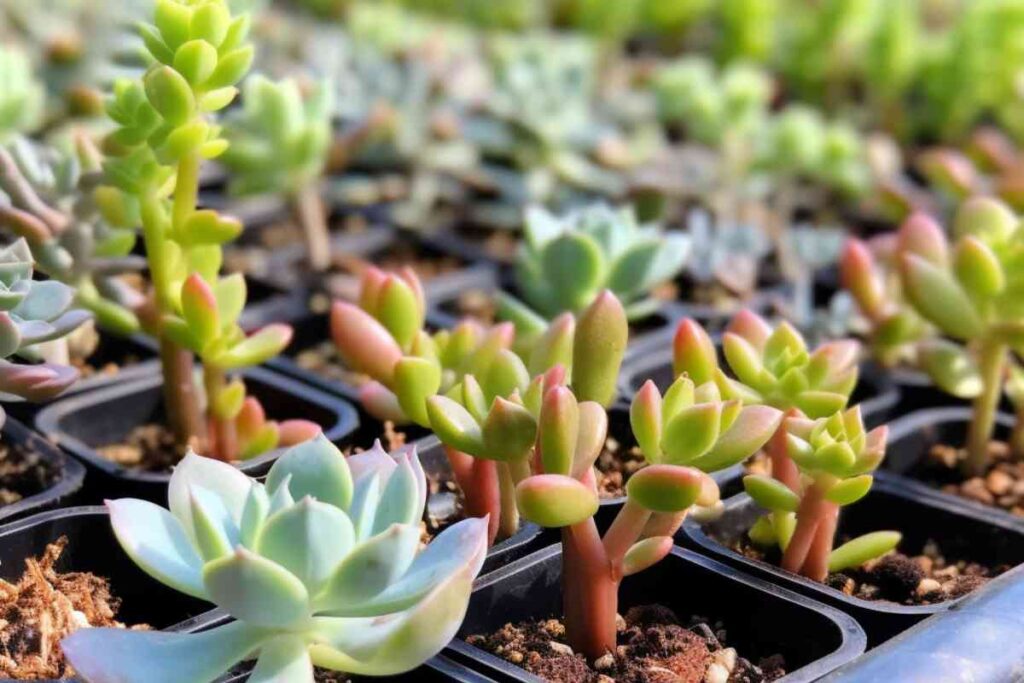How to Effectively Fix Root Rot in Succulents

I was thrilled and touched when a friend gifted me an adorable planter with a variety of succulents. She had spent far too much on it, and it was really gorgeous. It was one of my first forays into succulents. Their vibrant colors and unique shapes instantly won me over.
I couldn’t wait to care for these charming plants, but I was worried. I’d killed succulents before. Sure enough, my excitement soon turned to concern as I noticed the once thriving succulents becoming soft and droopy.
It was heartbreaking.
This time, I was going to do something about it. I was going to learn to fix root rot in succulents.

Here’s everything you need to know to save your succulent from root rot and ensure that it stays healthy from now on.
When you’re done learning how to save your succulent, find out whether it’s possible for succulents to survive without roots.
Is your succulent missing it’s roots for some reason other than root rot? Here’s how to save it.
Identifying Root Rot is Essential to Effectively Fix Root Rot in Succulents
Root rot is a fungal infection that can occur when the soil is too moist and doesn’t allow for proper drainage. We typically also describe a plant that has been consistently overwatered and has weak, rotting roots as having root rot, even if it doesn’t have the fungal infection

Signs of Root Rot
- Wilting or drooping leaves: One of the earliest signs of root rot in succulents is the wilting or drooping of leaves. The leaves may appear soft, mushy, or discolored.
- Yellowing or browning of leaves: As root rot progresses, the leaves of the succulent may start turning yellow or brown, beginning from the bottom of the plant and moving upwards.
- Soft and mushy roots: When checking the roots of a succulent with suspected root rot, gently remove it from its pot and examine the roots. Healthy roots are firm and white, while root rot will cause the roots to become soft, mushy, and discolored.
- Foul odor: Root rot can produce a foul smell, often described as musty or rotten. If you notice an unpleasant odor coming from your succulent’s soil or roots, it could be a sign of root rot.
- Stunted growth: Succulents with root rot may exhibit slow or stunted growth. They may not produce new leaves or shoots as they normally would.
- Black or darkened roots: In advanced stages of root rot, the roots may turn black or dark brown due to the decaying tissue. This is a clear indication that the plant is experiencing severe root damage.
- Loose or easily dislodged plant: If the roots of your succulent are severely rotted, they may no longer provide adequate support to the plant. As a result, the succulent may feel loose or wobbly in its pot.
- Excessive moisture in the soil: Succulents are adapted to dry conditions, so overwatering can lead to root rot. If the soil around the succulent feels constantly wet or waterlogged, it may contribute to the development of root rot.
- Poor drainage: Succulents require well-draining soil to prevent water from sitting around their roots. If the soil in the pot doesn’t drain properly or if there’s no drainage hole in the pot, it increases the risk of root rot.
- Plant discoloration or black spots: In addition to leaves, the stem or other parts of the succulent can show signs of discoloration or develop black spots. This can be an indication of root rot affecting the overall health of the plant.
- Abandoning ship: When a succulent is dying from root rot, it may drop leaves or break off in an attempt to find better soil.

Treating Root Rot
Action to Take
If you suspect root rot in your succulent, the first action to take is to remove it from its pot and inspect the roots. Gently remove the soil from the roots and check for any signs of rotting.
Healthy roots should be white or light brown, while rotting roots will be black, brown, or mushy. If you find any signs of rotting, you need to take immediate action to save your plant. All succulents are at risk of dying from root rot because of their water-storing nature.
Now, you need to decide what to do. Some succulents can be grown from leaves, while others can’t. If your succulent is the type that can grow from leaves, it’s a good idea to propagate some leaves separate from the rest of the succulent. This gives the primary succulent plenty of space along the stem for new roots and lets you get plenty of new pups.

Succulents that Grow from Leaves
This list is far from comprehensive, but it gives you a good idea of which common succulents can be leaf-propagated. As a rule, succulents with leaves that easily pop off can be propagated by leaf.
- Echeveria: Echeverias are popular succulents that readily propagate from leaves. Gently remove a healthy leaf from the parent plant, let it callus over for a few days, then place it on well-draining soil. Keep the soil lightly moist until new roots and rosettes form.
- Sedum: Sedums, also known as stonecrops, are another group of succulents that propagate well from leaves. Simply remove a leaf from the plant, allow it to callus for a few days, and place it on well-draining soil. Mist the soil occasionally to keep it lightly moist until new growth appears.
- Crassula: Crassulas, such as the Jade Plant (Crassula ovata), can be propagated from leaves. Take a healthy leaf from the parent plant, let it dry and callus for a few days, and place it on well-draining soil. Water sparingly until new roots and shoots emerge.
- Kalanchoe: Many varieties of Kalanchoe can be propagated from leaves. Remove a healthy leaf, let it callus over, and place it on well-draining soil. Keep the soil slightly moist until new plantlets develop.
- Graptopetalum: Graptopetalums are succulents that can be propagated from leaves. After removing a leaf, allow it to callus for a few days, then place it on well-draining soil. Water sparingly until new rosettes form.
- Aeonium: Some species of Aeonium can be propagated from leaves. Take a healthy leaf, let it callus, and place it on well-draining soil. Keep the soil lightly moist until new rosettes emerge.
- Pachyphytum: Pachyphytum succulents, such as Pachyphytum oviferum (Moonstones), can be propagated from leaves. Remove a healthy leaf, let it dry and callus for a few days, and place it on well-draining soil. Water sparingly until new plants form.
- Senecio: Some species of Senecio, like Senecio rowleyanus (String of Pearls), can be propagated from leaves. Take a healthy leaf, let it dry and callus, then lay it on top of well-draining soil. Keep the soil slightly moist until new roots and trailing stems develop.
- Crassula perforata (String of Buttons): Crassula perforata can be propagated from leaves as well. Gently remove a leaf, allow it to callus over, and place it on well-draining soil. Water sparingly until new plants emerge.
- Graptoveria: Graptoveria is a hybrid succulent resulting from crossing Graptopetalum and Echeveria. It can be propagated from leaves. Take a healthy leaf, let it callus for a few days, and place it on well-draining soil. Water sparingly until new rosettes appear.
- Aloe vera: Aloe vera can also be propagated from leaves. Select a mature leaf, cut it at an angle, and let it dry and callus for a few days. Then, plant the leaf vertically in well-draining soil, burying the cut end. Water sparingly until new roots and offsets emerge.

Succulents That Can’t Grow From Leaves
If you have a succulent that doesn’t have leaves that easily pop off, it probably can’t be propagated from leaves. In this case, you’ll need to cut the affected roots off and give the entire plant a chance to recover. Agan, this list isn’t exhaustive, but here are some common succulents that don’t grow well from leaves.
- Cacti: Most cacti are not well-suited for leaf propagation, although they are very susceptible to root rot. They have specialized areoles from which new growth emerges, making leaf propagation ineffective for them. Instead, cacti are typically propagated from offsets, stem cuttings, or seeds.
- Agave: Agave plants typically do not propagate well from leaves. They are monocarpic succulents, meaning they flower once and then die. While some agave species produce offsets or “pups” that can be separated and replanted, leaf propagation is not a common method for propagating agaves.
- Sempervivum (Hens and Chicks): Sempervivums are primarily propagated through offsets or “chicks” that develop around the base of the main plant. While leaves can occasionally produce small plantlets, it is generally more reliable and efficient to propagate Sempervivum through offsets.
- Agave attenuata (Foxtail Agave): Foxtail Agave is another succulent that is not typically grown from leaves. It produces offsets or pups at the base of the plant, which are the preferred method of propagation.
- Dudleya: Dudleya plants, including varieties like Dudleya brittonii (Giant Chalk Dudleya), are generally challenging to propagate from leaves. They primarily reproduce through offsets or stem cuttings.
- Saguaro cactus (Carnegiea gigantea): Saguaro cacti, known for their iconic tall stems with branching arms, are not typically propagated from leaves. They are slow-growing and primarily propagated from seeds or occasionally from stem cuttings.
- Stapelia: Stapelia is a genus of succulents that includes species like Stapelia gigantea (Carrion Flower). They have unique star-shaped flowers but are generally not propagated from leaves. They are more commonly propagated from stem cuttings or by division.
- Lithops: Lithops, also known as Living Stones, are small succulents that mimic rocks and have unique leaf pairs. They are challenging to propagate from leaves as they have specialized underground structures for water storage. Lithops are typically propagated from seeds or by division.
- Cereus cactus: Cereus cacti, which include species like Cereus peruvianus (Peruvian Apple Cactus), are not commonly propagated from leaves. They are typically grown from seeds or stem cuttings.
- Aeonium arboreum: Aeonium arboreum, commonly known as Tree Aeonium, is not typically grown from leaves. They are more easily propagated from stem cuttings or by separating offsets.

Beheading Succulents
When dealing with root rot in succulents, it is often necessary to propagate the plant to save it. Beheading is a common method of propagating succulents. Start by identifying the healthy portion of the plant and cutting it off just above the rot. The cut should be clean and straight, and the remaining stem should be allowed to callus over for a few days before planting.
Once the stem has callused, plant it in well-draining soil and water sparingly until roots begin to form. It’s important to keep the soil moist but not wet during this time to prevent further root rot. After roots have formed, the plant can be treated like any other succulent.
If your succulent can be leaf-propagated, snap or cut off the leaves along the lower part of the stem. Allow them to callous separately and plant them in new soil when they have roots starting. Once the mother plant has had time to callous, plant it with the stem where the leaves had been in the soil so it will have plenty of room to grow new roots.
(Beheading can also be used as a method of encouraging bushier growth in succulents. By cutting off the top of the plant, new growth will emerge from the sides of the remaining stem. This can be repeated as many times as desired to achieve the desired shape and size of the plant.)
Sterilizing Tools
Sterilizing your tools is crucial to prevent the spread of any diseases. You can sterilize your tools by wiping them down with rubbing alcohol or dipping them in a solution of one part bleach to nine parts water. Be sure to rinse your tools thoroughly with water after sterilizing them to remove any residue.
By following these steps, you can successfully treat root rot in your succulent and save your plant from further damage. Remember to monitor your plant regularly and avoid overwatering to prevent future occurrences of root rot.

Preventing Root Rot
Watering Succulents
I always make sure to water my succulents sparingly, allowing the soil to dry out completely before watering again. Overwatering is the main cause of root rot in succulents, so it’s important to be mindful of how much water your plants are receiving. During the winter months, I water my succulents even less frequently since they aren’t actively growing.
Soil and Drainage
Using a well-draining soil mix is crucial in preventing root rot in succulents. I like to mix my own soil using a combination of potting soil, sand, and perlite. It’s also important to make sure your pots have drainage holes to allow excess water to escape. If your pot doesn’t have drainage holes, drill some yourself.
Repotting Succulents
Repotting your succulents every once in a while can also help prevent root rot. When succulents become very rootbound, they can block drainage holes and trap water in the roots.
When repotting, make sure to remove any dead or rotting roots and replace the soil with fresh, well-draining soil. If roots seem soft or overwatered, consider mixing a better-draining soil.
Effectively Fix Root Rot in Succulents
Prevention is key to avoid killing your plants due to rotting roots. Once the roots are infected, the rot can spread quickly, caused by bacteria or mold in wet soil.
However, by removing the infected roots and repotting the plant in dry soil, you can save it and even get lots more baby plants.
Learn everything there is to know about caring for succulents so you never have a problem like root rot again.
Do you have a bunch of pups now that you’ve saved your succulent and propagated leaves? These mini succulent garden ideas are perfect for those tiny succulents.


